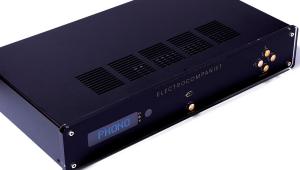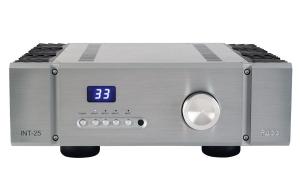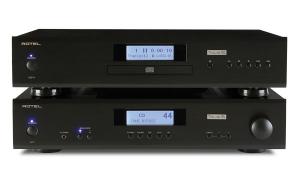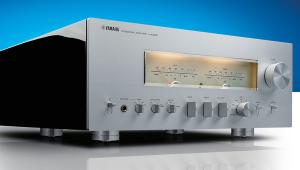Audiolab 6000A

 Audiolab was started in the bedroom of Philip Swift’s Cambridge house back in the autumn of 1982. “We wanted to make a very high-performance product at a very affordable price, one which was also practical and reliable,” he once told me. The first Audiolab 8000A integrated amplifier made its debut on hi-fi dealers’ shelves in 1983, and the brand never looked back. Now selling as the 8300A (HFC 420), this remains one of hi-fi’s evergreens, selling to the type of buyer that demands quality, flexibility and power – but nothing too flashy.
Audiolab was started in the bedroom of Philip Swift’s Cambridge house back in the autumn of 1982. “We wanted to make a very high-performance product at a very affordable price, one which was also practical and reliable,” he once told me. The first Audiolab 8000A integrated amplifier made its debut on hi-fi dealers’ shelves in 1983, and the brand never looked back. Now selling as the 8300A (HFC 420), this remains one of hi-fi’s evergreens, selling to the type of buyer that demands quality, flexibility and power – but nothing too flashy.
The new 6000A is very much about “traditional values in a modern setting” and it expands the number of sources that the original could handle, adding DAC functionality and Bluetooth wireless connectivity with aptX support, as well as having a moving-magnet phono stage and headphone output just as the original did. Audiolab’s Jan Ertner – the man responsible for the electronic design – has taken a lot of trouble on the digital side. It sports an ESS Sabre ES9018 converter chip, as seen on the M-DAC launched back in 2011 and reviewed in HFC 359. Although getting on now, it’s still highly regarded and this amp benefits from work done to the post-DAC active filter.
Four S/PDIF digital inputs – two coaxial and two optical – support up to 24-bit/192kHz PCM. Although no high-flyer in the hi-res format support stakes compared with some of Audiolab’s other components, the 6000A offers real-word compatibility for the majority of people. Three user-selectable digital filters – fast roll-off, slow roll-off and minimum phase – let you tune the sound to taste.
At the heart of the amplifier, there’s a discrete Class AB power amp stage delivering a claimed 50W per channel into 8ohm and 75W per side into 4. The output stage uses complementary feedback topology, which Audiolab claims gives superior linearity and good thermal stability, as the idle current is kept independent of the temperature of the output transistors. Meanwhile, the preamplifier section is as simple as possible, giving -80dB to +8dB in steps of 2dB and 1dB – the step resolution increases the higher the volume position. The unit is neatly laid out under the case, keeping the preamp section away from noise generation as much as possible.
It’s funny how things come back into fashion and so it is that the 6000A sports a JFET-based phono preamplifier section. Lest we forget, it was only in the mid-nineties with the advent of the 8200A, that Audiolab dumped phono stages, tone controls and headphone outputs. There are three operational modes – integrated, pre-power and preamplifier. The mode selector toggles between these, and also gives the set-up menu where you can select balance, digital filter type and standby time, etc. Overall, the 6000A is a very tidily packaged integrated that’s easy to use.
Sound quality
If you’ve heard a classic Audiolab 8000A, it’s fair to say this new offering won’t come as too much of a surprise to your ears. This is a surprisingly sophisticated-sounding integrated that belies its low price and never offends sonically. It presents a dry and clean rendition of the music, with no overhang in the bass or any sense of richness or bloat. The midband is clean and spry, casting a light on the recording that leaves little room for doubt about what’s going on. Up top, treble is crisp and accurate with a well-etched feel.
The result is that thin-sounding recordings like The Wind Blows Your Hair by Naz Nomad And The Nightmares – The Damned’s alter ego as pop-pickers will know – don’t get any sweeter. Actually, the song proves very enjoyable, in spite of the rather matter-of-fact tonality that is delivered. Feed it a warmer track like White Bird by It’s A Beautiful Day, and things do defrost just a little, but you’re hardly cosseted by the amplifier’s opulent tonality. For this reason, anyone contemplating buying this integrated should consider partnering it with rich, full-sounding speakers, as opposed to more analytical ones.
Despite its dry tonality, it still proves great fun to hear. Bassheads’ classic electro stomper Is There Anybody Out There? proves a joy – the Audiolab serves up serious amounts of power with my reference Cambridge Audio Aeromax 6 floorstanders (HFC 391), moving air around the room with alacrity. Although not the world’s most emotional-sounding amplifier, it’s good at transients and duly captures the natural starts and stops of the electronic percussion very well indeed. You get quite a technical style of presentation, yet it’s enjoyable all the same. I find myself focusing in on the interplay between the snare sound and the looped hi-hats, as the bass synthesiser punches out vast tracts of low frequencies with surprising ease.
Feed the Audiolab with a high-quality rock recording such as Peter Gabriel’s Here Comes The Flood, and you’re able to enjoy its spacious nature to the full and I am beguiled by the confident and expansive soundstage that it conjures up. Instruments in the mix are pushed far stage left and stage right, and Gabriel’s vocals hang in the middle with real confidence. In absolute terms the 6000A is a little two-dimensional when it comes to depth perspective, with a slight dip in stage depth, but it’s still surprisingly capacious considering the price.
Switching between inputs, there is no obvious failing. Bluetooth is perhaps the least sonically convincing, of the bunch, but being decently implemented aptX it handles the signal well and sounds surprisingly engaging. The DAC input proves way better than many similarly priced rivals with a wide and confident sound and lots of detail. The analogue inputs do well too, easily able to signpost the differences between CD players at a variety of prices while the phono stage gives a fine sound when partnered with a Rega Planar 2 (HFC 415) and achieves super results.
Conclusion
Audiolab’s 6000A is a cracking budget integrated with just the right amount of facilities, a snappy and engaging sound, sufficient power and fine build. A great buy for the modern music fan who wants plenty of flexibility. DP
DETAILS
Product: Audiolab 6000A
Price: £599
Origin: UK/China
Type: Integrated amplifier
Weight: 7.8kg
Dimensions: (WxHxD) 445 x 66 x 300mm
FEATURES
● Quoted power output: 2x 50W into 8ohm
● Digital inputs: 2x optical; 2x coaxial; Bluetooth with aptX
● Analogue inputs: 3x RCAs; 1x MM phono
 |
Inside this month's issue:
Q Acoustics 3020c standmount loudspeakers, Perlisten R10s active subwoofer, Quad 33 and 303 pre/power amps, Acoustic Solid Vintage Full Exclusive turntable, newcomer Fell Audio Fell Amp and Fell Disc and lots, lots more...
|





















































